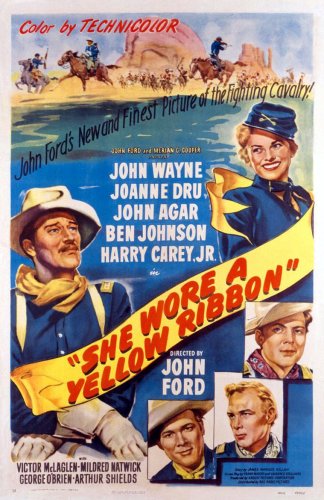

The film says that news of the Battle of Little Big Horn (1876) was spread by the Pony Express - which went out of business in 1861.
The calendar page that Capt.
Brittles uses to mark off the days until his retirement is for the wrong month.
The calendar most unusually shows the year but not the month, but it does show that the month has 31 days and begins on a Wednesday.
Therefore, the only month in 1876 that this page would have fit was March.
But it cannot be March, because it refers to the Battle of the Little Big Horn as having recently occurred and that Battle did not take place until June 1876.
Arguably, the calendar should show the month of July, because John Wayne's character indicates that it is the 5th of the month, and news of Custer's death at Little Big Horn on Sunday June 25 would have taken about two weeks to arrive by (anachronistic) pony express.
Prior to leaving Fort Stock on his last patrol, Captain Brittles writes an objection to having to take a wagon on the mission.
He hands the written complaint to Major Allshard, who in turn hands it to Sgt.
Hochbauer, who then reads the report up side down.
During the fight in the canteen, when Sgt.
Quincannon throws the small soldier over the counter, the barman Connolly has his pipe in his mouth.
In the next shot, his pipe is in his right hand.
When Capt Brittles asks the Post commander's wife if the dress she is wearing is made from Top Soldier Quincanon's britches, she agrees, but the skirt is a full ankle length riding skirt made from much more material than a pair of britches.
During the charge, you hear the same looped recordings of war whoops over and over again.
Furthermore, they are the same looped recordings of war whoops that they used the previous year in "Fort Apache".
Captain Brittles is retiring after 40 years in the army.
It is 1876, which means he entered the army around 1836.
He says he was "just a boy in blue jeans" when he entered the army.
Blue jeans or denim trousers didn't come into the U.
until Levi Strauss brought the material from DeNimes France to California during the 1850 gold rush.
There were no "blue jeans" in the 1830s.
When Sgt.
Tyree stops the paymaster's stage coach, he walks back past the horses to the coach.
In the footwell of the driver's seat there are two holes through which the reins pass.
The head of the stuntman who was driving the "driverless" coach is visible.
As Dr.
O'Laughlin is operating on Cpl.
Mike Quayne, exterior views of their wagon include a modern Coleman-type two-mantle lantern, which was not available in 1876.
Despite the demise of the 'Pony Express' in 1861 and the completion of the telegraph in 1862, notification in many areas, even in 1876, still traveled by horse.
The Custer column from Fort Lincoln did not string telegraph lines as it moved west to engage the 'hostile Indians'.
After the 'massacre', the word was sent East, at least to Fort Lincoln, by courier on horseback.
It took nearly two weeks for the word to reach the East Coast (General Sherman on July 4th).
When Captain Brittles is talking to Chief Pony That Walks in the Indian encampment, the chief's beaded necklace is around his neck in one shot and over his arm in the next; the camera angle switches numerous times.
While traveling in southern Utah, the troops come across a traveling band of Arapaho.
The Arapaho lived in eastern Colorado and Wyoming and would be an unlikely find in southern Utah.
When Sgt Tyree brings in the paymasters stage and the doctor is examining the Paymasters body, we see the doctors hat and bag on the ground next to the doctor.
In the next shot, the doctor's hat is leaning against the doctors bag.
After Capt Brittles says goodbye to the troops and rides back to his quarters, he makes a very showy gesture of tying up his horse's reigns to the hitching post which the horse undoes a moment later with a shake of his head.
And, though seeing it, Capt Brittles makes no attempt to re-tie up the reigns.
The cavalrymen in 1876 wear greatcoats with a yellow lining, a pattern that was not introduced until 1883.
After the defeat of General Custer, fear spreads across the plains as angry Indian tribes gather to take on the US Calvary. Veteran Captain Nathan Cutting Brittles (John Wayne) leads a remote outpost and eagerly waits for his retirement in six days.
Directed by John Ford. Starring John Wayne, John Agar, Joanne Dru, Harry Carey Jr.
. .
. .
John Wayne plays Capt. Nathan Brittles, whose imminent plans of retirement are interrupted by General Custer's forces being wiped out in his famous "last stand".
I remember seeing this film when I was a Youngster. I have watched it many times, always a favorite.
Looks beautiful and the acting's excellent.Brought tears to my eyes.
I don't much care for Westerns as a genre and especially not when they're served straight up. But if I'm going to watch one, I want to watch a John Ford Western, since he almost always was interested in more than just standard Western tropes and always used their conventions to explore other things on his mind.
I grew up on John Wayne and John Ford, and they're both on good form here. No other director can match Ford's El Greco-like luminousness, and Wayne gives one of his better performances in which he unusually has to show a vulnerable side.